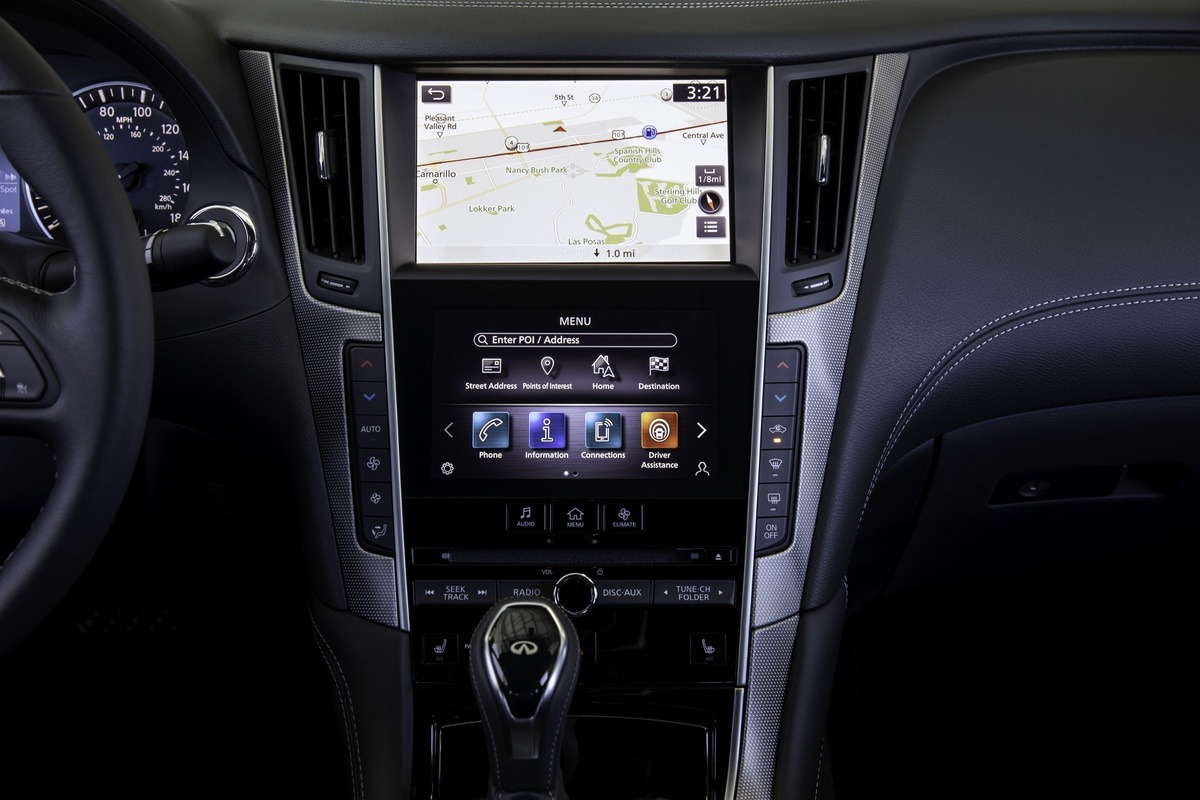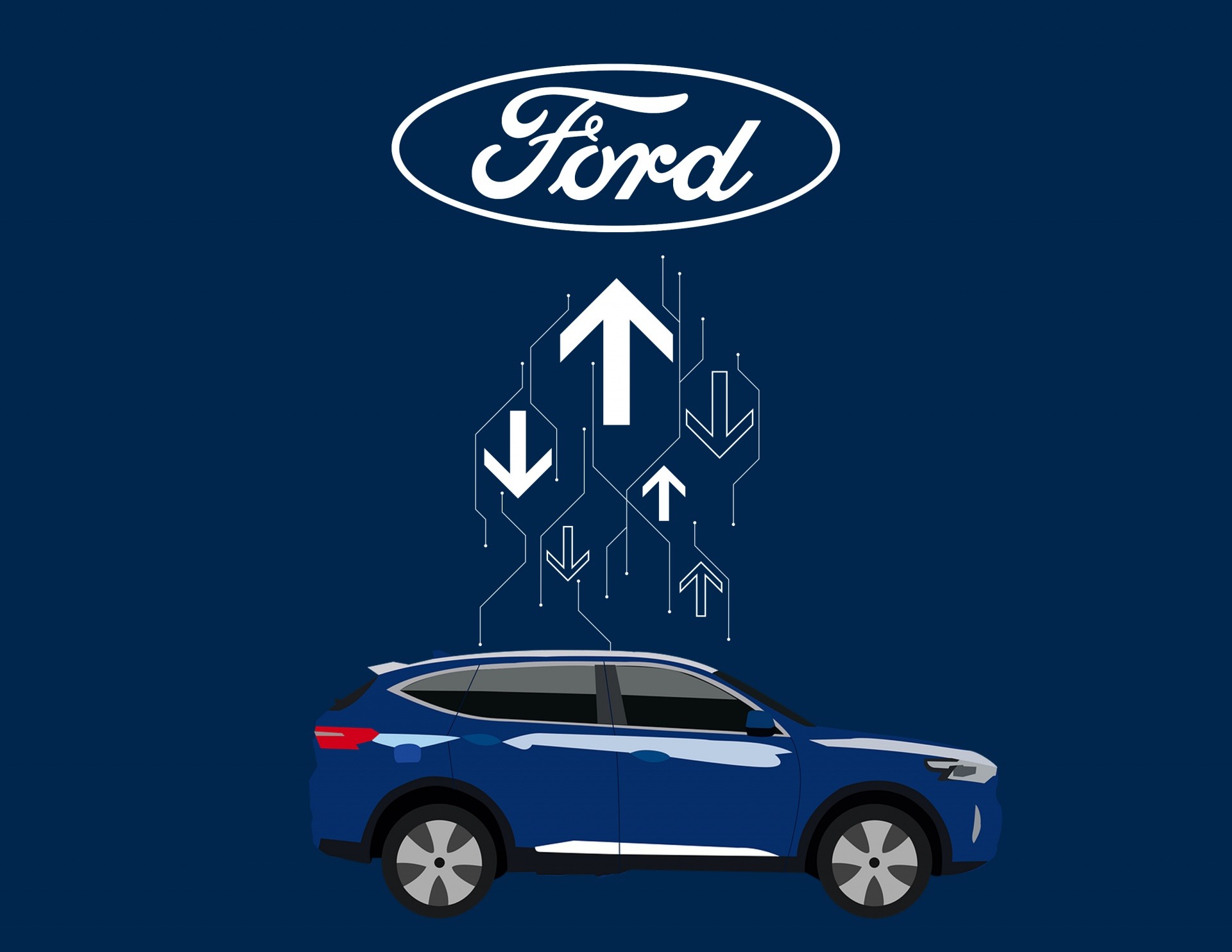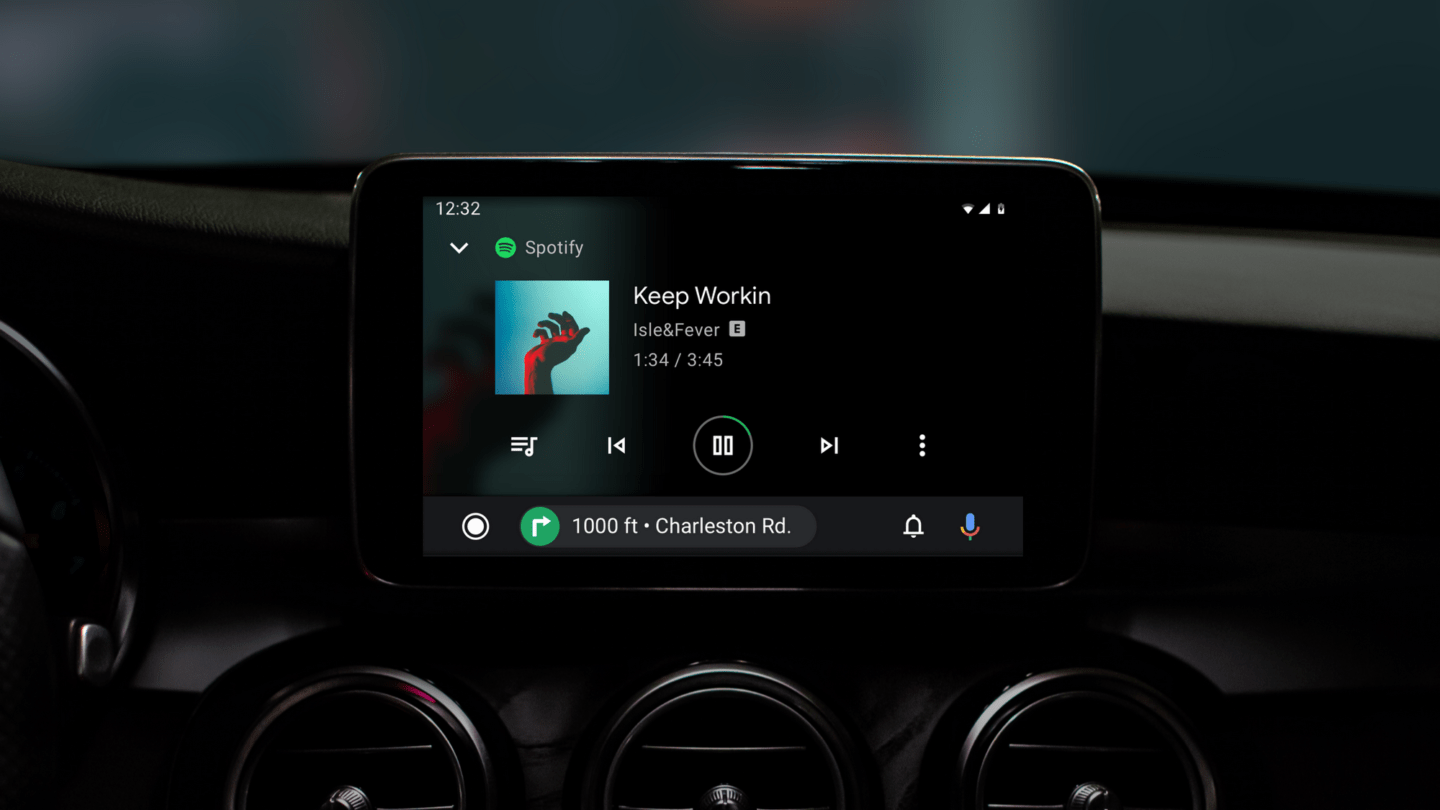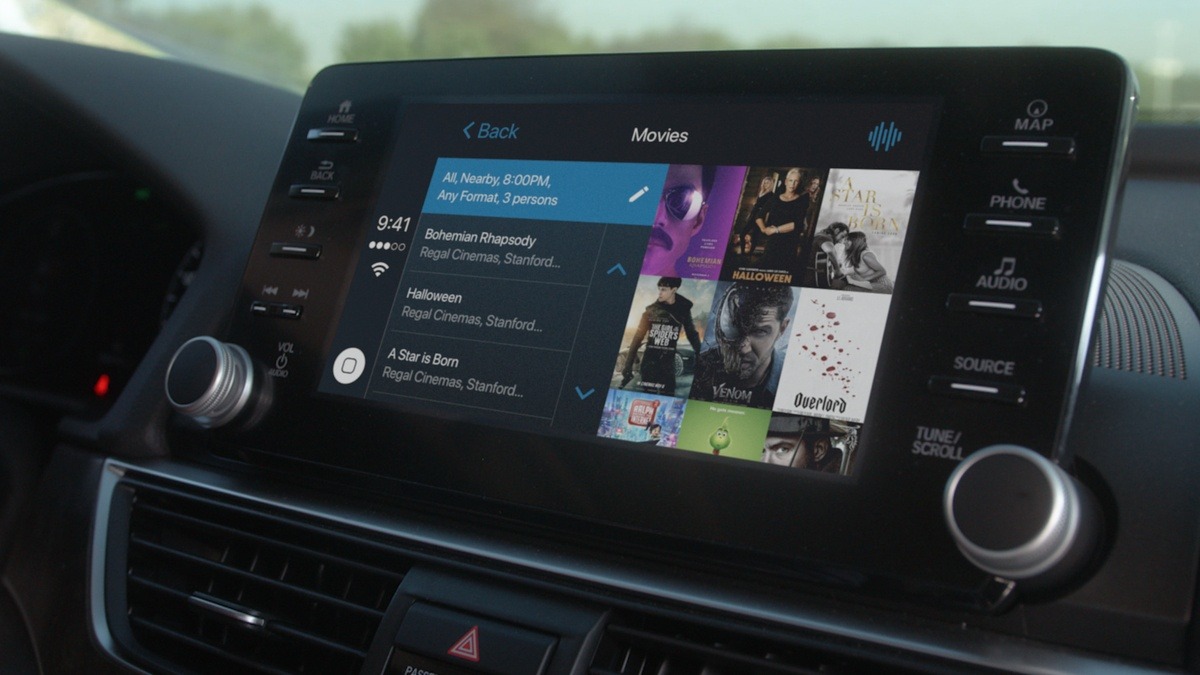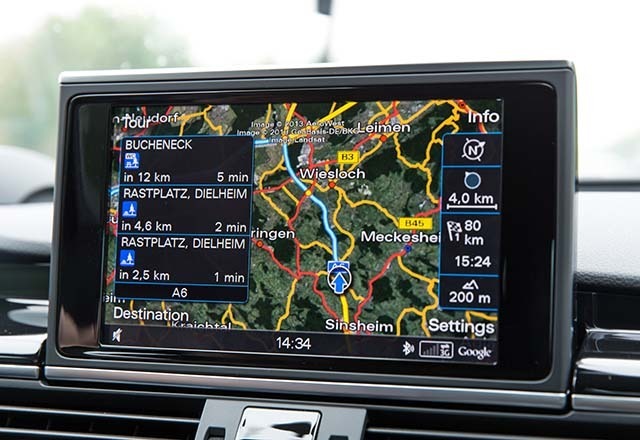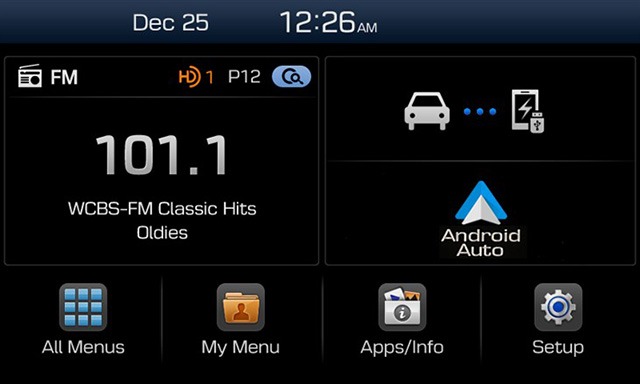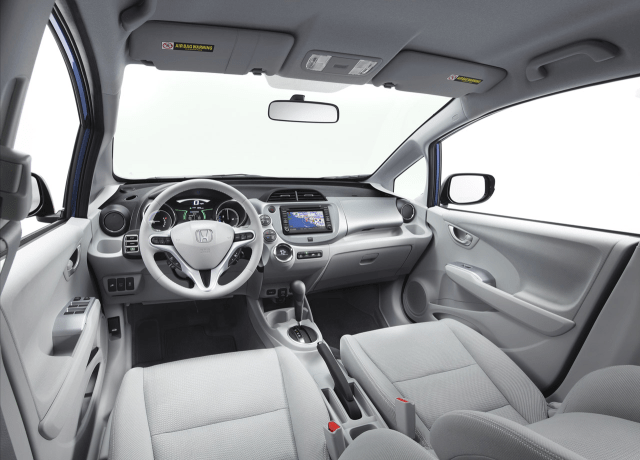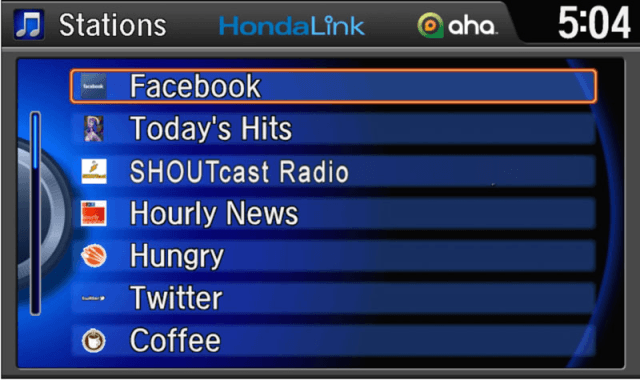Search the Community
Showing results for tags 'Infotainment'.
-
Infiniti will be releasing the next generation of their infotainment system, InTouch, for the 2020 model year. Most of their lineup, except the QX60, get the updated system. The biggest news is that the new system will now support Apple CarPlay and Android Auto standard. The system can get over the air updates via their home's wifi or systems with navigation can have a data plan to do the updates. The navigation system can also receive real-time traffic data for re-routing and turn-by-turn directions. Infiniti has upgraded the interface to be easier to use and has added more processing power behind the system. They've also upgraded the bluetooth module for easier pairing and a better microphone for improved voice quality. View full article
- 29 replies
-
- infinit
- infotainment
- (and 4 more)
-

Infiniti Updates Infotainment Systems for 2020 Model Year
Drew Dowdell posted an article in Infiniti
Infiniti will be releasing the next generation of their infotainment system, InTouch, for the 2020 model year. Most of their lineup, except the QX60, get the updated system. The biggest news is that the new system will now support Apple CarPlay and Android Auto standard. The system can get over the air updates via their home's wifi or systems with navigation can have a data plan to do the updates. The navigation system can also receive real-time traffic data for re-routing and turn-by-turn directions. Infiniti has upgraded the interface to be easier to use and has added more processing power behind the system. They've also upgraded the bluetooth module for easier pairing and a better microphone for improved voice quality.- 29 comments
-
- infinit
- infotainment
- (and 4 more)
-
Starting in 2020, Ford will be launching Sync 4 in most updated and redesigned vehicles. One of the key features of the new infotainment operating system is the ability to get updates over the air via a cellular network. The over-the-air update ability makes updating the system as easy as a cell phone. In Sync 3, the system was able to be updated via a wifi network or USB drive, and that is how Ford rolled out Apple CarPlay and Android Auto when they were finally made available for Sync 3. Ford says this change could eliminate some trips to the dealership if the computer needs to be reflashed to updated as part of a recall. The system has the ability to update software in the background and keep the current software running until the new update is ready for activation, making many of the updates completely invisible to the end user. Customers can schedule updates for a specific time, such as the middle of the night, to further make the process invisible. Sync 4 is designed to run on 8-inch screens standard, but 12-inch and 15.5-inch screens are available too. Voice recognition in Sync 4 is activated by saying "Ok Ford". Ford believes performing some recall work via the OTA updates will improve customer satisfaction and increase business. Ford has not released which models will get Sync 4 first.
-
- 1
-

-
- ford
- infotainment
-
(and 2 more)
Tagged with:
-
Starting in 2020, Ford will be launching Sync 4 in most updated and redesigned vehicles. One of the key features of the new infotainment operating system is the ability to get updates over the air via a cellular network. The over-the-air update ability makes updating the system as easy as a cell phone. In Sync 3, the system was able to be updated via a wifi network or USB drive, and that is how Ford rolled out Apple CarPlay and Android Auto when they were finally made available for Sync 3. Ford says this change could eliminate some trips to the dealership if the computer needs to be reflashed to updated as part of a recall. The system has the ability to update software in the background and keep the current software running until the new update is ready for activation, making many of the updates completely invisible to the end user. Customers can schedule updates for a specific time, such as the middle of the night, to further make the process invisible. Sync 4 is designed to run on 8-inch screens standard, but 12-inch and 15.5-inch screens are available too. Voice recognition in Sync 4 is activated by saying "Ok Ford". Ford believes performing some recall work via the OTA updates will improve customer satisfaction and increase business. Ford has not released which models will get Sync 4 first. View full article
-
- ford
- infotainment
-
(and 2 more)
Tagged with:
-
If you're the owner of an Android phone and an Android Auto enabled vehicle, this summer there will be a big upgrade coming to the interface of both. The new design will allow you to do more with fewer taps, while also showing more information on the screen at a time. As soon as you start your car, Android Auto will pick up where you left off with your media and automatically show your navigation app of choice. Navigation will show a suggested list of places or the user can say "Hey Google" to navigate to a new place. At the bottom will be a navigation bar that will allow users to control apps and see turn-by-turn navigation instructions even while on a Media or Phone screen. The color pallet has changed to a darker theme which is easier on the eyes. The font has been changed to be easier to read. In vehicles with wider screens, Android Auto will now fill that extra space with additional information such as next-turn direction, playback controls, or ongoing call information. You can see the new animations and look at the video below. These changes will be available on all Android Auto capable devices this summer. View full article
-
If you're the owner of an Android phone and an Android Auto enabled vehicle, this summer there will be a big upgrade coming to the interface of both. The new design will allow you to do more with fewer taps, while also showing more information on the screen at a time. As soon as you start your car, Android Auto will pick up where you left off with your media and automatically show your navigation app of choice. Navigation will show a suggested list of places or the user can say "Hey Google" to navigate to a new place. At the bottom will be a navigation bar that will allow users to control apps and see turn-by-turn navigation instructions even while on a Media or Phone screen. The color pallet has changed to a darker theme which is easier on the eyes. The font has been changed to be easier to read. In vehicles with wider screens, Android Auto will now fill that extra space with additional information such as next-turn direction, playback controls, or ongoing call information. You can see the new animations and look at the video below. These changes will be available on all Android Auto capable devices this summer.
-
At the Consumer Electronics Show in Las Vegas NV, Honda is demonstrating a prototype of their new Honda Dream Drive infotainment system. The new system integrates both driver and passenger infotainment. For the driver, Honda Dream Drive offers an expansion of Honda's existing in-vehicle payment system. It allows drivers to pay for fuel, movie tickets, food pickup or delivery, and parking. Additionally, the system can make restaurant reservations and share the vehicle location with family and friends. Originally exclusively through Visa, the payment system now include Mastercard and Paypal. For passengers, Honda Dream Drive offers games, watch movies, listen to music, use travel apps, and explore points of interest along the route, all from the passengers' mobile device. As this is a demonstration of a prototype, there is no official release date announced for Honda Dream Drive. View full article
- 8 replies
-
- dream drive
- honda
-
(and 1 more)
Tagged with:
-

CES 2019: Honda introduces Honda Dream Drive Infotainment System
Drew Dowdell posted an article in C.E.S.
At the Consumer Electronics Show in Las Vegas NV, Honda is demonstrating a prototype of their new Honda Dream Drive infotainment system. The new system integrates both driver and passenger infotainment. For the driver, Honda Dream Drive offers an expansion of Honda's existing in-vehicle payment system. It allows drivers to pay for fuel, movie tickets, food pickup or delivery, and parking. Additionally, the system can make restaurant reservations and share the vehicle location with family and friends. Originally exclusively through Visa, the payment system now include Mastercard and Paypal. For passengers, Honda Dream Drive offers games, watch movies, listen to music, use travel apps, and explore points of interest along the route, all from the passengers' mobile device. As this is a demonstration of a prototype, there is no official release date announced for Honda Dream Drive.- 8 comments
-
- dream drive
- honda
-
(and 1 more)
Tagged with:
-
What is the big problem with new cars? According to a new survey, it happens to be the infotainment systems. A study done by automotive consultants SBD and polling firm Nielsen asked some 14,000 owners about features in their cars and asked which ones were the best and the worst. The ten that scored the lowest in the survey were all related in some form to the infotainment system. These included smart phone integration, built-in apps, customizable instrument panels, and voice recognition. “It’s sort of an arms race -- who can have the most technology in the vehicle -- and consumers are confused,” said Nielsen Vice President Mike Chadsey at a connected-car symposium yesterday. The study also showed that 43 percent of participants said automakers are adding too much infotainment tech. So why are automakers adding all of this tech? Andrew Hart, director of SBD explained that automakers add all sorts of tech to draw in customers and to help boost revenue. But this might backfire as owners might go to another brand because of how bad the infotainment system was. If you to improve the chances of owner sticking with your brand, just get the infotainment right, getting the right set of features that people actually want to use and making them easy to use,” said Hart. Source: Automotive News (Subscription Required) View full article
-
What is the big problem with new cars? According to a new survey, it happens to be the infotainment systems. A study done by automotive consultants SBD and polling firm Nielsen asked some 14,000 owners about features in their cars and asked which ones were the best and the worst. The ten that scored the lowest in the survey were all related in some form to the infotainment system. These included smart phone integration, built-in apps, customizable instrument panels, and voice recognition. “It’s sort of an arms race -- who can have the most technology in the vehicle -- and consumers are confused,” said Nielsen Vice President Mike Chadsey at a connected-car symposium yesterday. The study also showed that 43 percent of participants said automakers are adding too much infotainment tech. So why are automakers adding all of this tech? Andrew Hart, director of SBD explained that automakers add all sorts of tech to draw in customers and to help boost revenue. But this might backfire as owners might go to another brand because of how bad the infotainment system was. If you to improve the chances of owner sticking with your brand, just get the infotainment right, getting the right set of features that people actually want to use and making them easy to use,” said Hart. Source: Automotive News (Subscription Required)
-
The past few years in the automotive industry has seen an explosion in technologies - whether its dealing improving the overall safety of a vehicle or figuring out a way to hook up your smartphone. Some of the tech makes the driving experience better, while others don't. So what do consumers think about the new technologies coming into vehicles? J.D. Power decided to find out. In their 2015 US Tech Choice Study, the company asked 5,300 consumers who either bought or leased a new vehicle within the past five years about the technologies that are being put in vehicles. Their results are interesting to say in the least. For example, safety tech is a big item for consumers. 40 percent of those surveyed expressed interest in blind-spot monitoring systems, 33 percent were interested in night vision systems, and 30 percent said they were intrigued by crash mitigation systems, along with backup cameras. Was there technologies that consumers couldn't really care about. Very much so. Only nine percent on consumers wanted gesture controls and further eight percent said they wanted haptic feedback in the touchscreen. J.D. Power also asked consumers about Apple's Carplay and Android Auto, systems that allow you to use phone via the infotainment system. Unsurprisingly, preference for either system came down to what phone you had. Notably, neither system garnered high marks in the survey. "Owners of luxury vehicles tend to own iOS devices,[1] so for many luxury brands, offering Apple CarPlay may be the best option, realizing they may be leaving out a portion of the market. For non-luxury vehicle brands, the ownership of Apple and Android devices is much closer to an equal split. The solution for those brands may be to offer both operating systems and allow customers to select the option best suited for them," said Kristin Kolodge, executive director of driver interaction & HMI research at J.D. Power. Finally, J.D. Power's survey showed that Gen Y is willing to spend for tech. According to the survey results, Gen Y willing to spend an average of $3,703, followed by Gen X with an average of $3,003, and Baby Boomers spending an average of $2,416. Source: J.D. Power Press Release is on Page 2 J.D. POWER 2015 U.S. TECH CHOICE STUDY Consumer Preference for Collision Protection Technologies Paves the Way for Autonomous Driving Apple CarPlay vs. Google Android Auto? It Depends on Your Phone WESTLAKE VILLAGE, Calif.: 22 April 2015 - Three of the top five technologies consumers most prefer in their next vehicle are related to collision protection, according to the J.D. Power 2015 U.S. Tech Choice StudySM released today. Technologies that reduce the overall burden of driving and enhance the safety of the vehicle and its occupants receive the most consumer attention. Among the technologies consumers express most interest in having in their next vehicle are blind spot detection and prevention systems, night vision, and enhanced collision mitigation systems. These findings demonstrate growing customer acceptance towards the concept of the vehicle taking over critical functions such as braking and steering, which are the foundational building blocks leading to the possibility of fully-autonomous driving. The only non-collision protection technologies to crack the top five are camera rearview mirror, which falls into the driving assistance category, and self-healing paint, a comfort and convenience category. The inaugural study uses advanced statistical methodologies to measure preference for and perceived value of future and emerging technologies. A total of 59 advanced vehicle features are examined across six major categories: entertainment and connectivity; comfort and convenience; collision protection; driving assistance; navigation; and energy efficiency. "There is a tremendous interest in collision protection technologies across all generations, which creates opportunities across the market," said Kristin Kolodge, executive director of driver interaction & HMI research at J.D. Power. "In contrast, there is very little interest in energy efficiency technologies such as active shutter grille vents and solar glass roofs. Owners aren't as enthusiastic about having these technologies in their next vehicle because of other efforts automakers are taking to improve fuel economy, as well as relatively low fuel prices at the present time." Apple CarPlay vs. Google Android Auto Smartphones play an increasingly vital role in everyday life, and vehicle technology is beginning to mirror what is offered on those devices, yet Apple CarPlay and Google Android Auto technologies consistently have among the lowest preference scores across all generations. Consumer preferences for Apple CarPlay and Android Auto are uniquely dependent on which smartphone they own. Those who currently own a smartphone that is compatible with one of these technologies would choose the technology compatible with their phone at only a moderate rate, while those with the opposite brand of smartphone will rarely, if ever, choose that technology. For example, Android owners indicate that Apple CarPlay is "unacceptable" nearly twice as often as they indicate that solar glass roof is unacceptable. Similarly, Apple phone owners indicate that Android Auto is "unacceptable" nearly twice as often as solar glass roof. Kolodge noted that "lukewarm interest in these technologies that connect your phone to your vehicle coupled with consumer loyalty to their phone poses a unique challenge for automakers, which could be remedied by knowing their customers' phone preferences." "Owners of luxury vehicles tend to own iOS devices,[1] so for many luxury brands, offering Apple CarPlay may be the best option, realizing they may be leaving out a portion of the market," said Kolodge. "For non-luxury vehicle brands, the ownership of Apple and Android devices is much closer to an equal split. The solution for those brands may be to offer both operating systems and allow customers to select the option best suited for them." Gen Y Willing to Spend Most for Technology Across all generations[2], price is the most important consideration for technology, accounting for 25.2 percent of importance. Gen Y is the least sensitive to technology price and shows a greater willingness to spend on new technologies than the other generations. Gen Y consumers, who have accounted for 27.7 percent of new-vehicle sales thus far in 2015[3]-second only to Boomers at 37.1 percent-are willing to spend an average of $3,703 on technology for their next vehicle. Gen X is willing to spend $3,007, while Boomers, who show the greatest price sensitivity, and Pre-Boomers are willing to spend only $2,416 and $2,067, respectively. Importance of Technology A certainty in the automotive domain is the impact the consumer electronics world has had upon it. From shifting consumer expectations of user interaction, to the rapid pace of technology introduction and importance of keeping software up to date, to the miniaturization and creation of cost-effective solutions for sensors and cameras, "the auto industry is standing on its head to keep technology up to consumers' new standards," said Kolodge. "Those who haven't done so have seen negative feedback from consumers." KEY FINDINGS Full self-driving automation technology, part of the collision protection category, is designed to perform all safety-critical driving functions and monitor roadway conditions. The younger generations (Gen Y and Gen X) have substantially higher preference for the technology than the older generations (Boomer and Pre-Boomer). The Pre-Boomer generation, in contrast, has a greater preference for lower levels of automation, such as traffic jam assist. ŸBlind spot detection and prevention has high preference across the range of vehicle price segments. In contrast, reverse auto braking systems have low preference across the vehicle price segments and preference wanes as vehicle prices increase. ŸAdvanced sensor technologies, such as hand gesture controlled seats, biometric driver sensors or haptic touch screens have low preference. ŸTechnologies in the navigation category have low preference across all vehicle price segments. The 2015 U.S. Tech Choice Study was fielded in January through March 2015 and is based on an online survey of more than 5,300 consumers who purchased/leased a new vehicle in the past five years.
- 2 comments
-
- Controls
- Infotainment
-
(and 4 more)
Tagged with:
-
The past few years in the automotive industry has seen an explosion in technologies - whether its dealing improving the overall safety of a vehicle or figuring out a way to hook up your smartphone. Some of the tech makes the driving experience better, while others don't. So what do consumers think about the new technologies coming into vehicles? J.D. Power decided to find out. In their 2015 US Tech Choice Study, the company asked 5,300 consumers who either bought or leased a new vehicle within the past five years about the technologies that are being put in vehicles. Their results are interesting to say in the least. For example, safety tech is a big item for consumers. 40 percent of those surveyed expressed interest in blind-spot monitoring systems, 33 percent were interested in night vision systems, and 30 percent said they were intrigued by crash mitigation systems, along with backup cameras. Was there technologies that consumers couldn't really care about. Very much so. Only nine percent on consumers wanted gesture controls and further eight percent said they wanted haptic feedback in the touchscreen. J.D. Power also asked consumers about Apple's Carplay and Android Auto, systems that allow you to use phone via the infotainment system. Unsurprisingly, preference for either system came down to what phone you had. Notably, neither system garnered high marks in the survey. "Owners of luxury vehicles tend to own iOS devices,[1] so for many luxury brands, offering Apple CarPlay may be the best option, realizing they may be leaving out a portion of the market. For non-luxury vehicle brands, the ownership of Apple and Android devices is much closer to an equal split. The solution for those brands may be to offer both operating systems and allow customers to select the option best suited for them," said Kristin Kolodge, executive director of driver interaction & HMI research at J.D. Power. Finally, J.D. Power's survey showed that Gen Y is willing to spend for tech. According to the survey results, Gen Y willing to spend an average of $3,703, followed by Gen X with an average of $3,003, and Baby Boomers spending an average of $2,416. Source: J.D. Power Press Release is on Page 2 J.D. POWER 2015 U.S. TECH CHOICE STUDY Consumer Preference for Collision Protection Technologies Paves the Way for Autonomous Driving Apple CarPlay vs. Google Android Auto? It Depends on Your Phone WESTLAKE VILLAGE, Calif.: 22 April 2015 - Three of the top five technologies consumers most prefer in their next vehicle are related to collision protection, according to the J.D. Power 2015 U.S. Tech Choice StudySM released today. Technologies that reduce the overall burden of driving and enhance the safety of the vehicle and its occupants receive the most consumer attention. Among the technologies consumers express most interest in having in their next vehicle are blind spot detection and prevention systems, night vision, and enhanced collision mitigation systems. These findings demonstrate growing customer acceptance towards the concept of the vehicle taking over critical functions such as braking and steering, which are the foundational building blocks leading to the possibility of fully-autonomous driving. The only non-collision protection technologies to crack the top five are camera rearview mirror, which falls into the driving assistance category, and self-healing paint, a comfort and convenience category. The inaugural study uses advanced statistical methodologies to measure preference for and perceived value of future and emerging technologies. A total of 59 advanced vehicle features are examined across six major categories: entertainment and connectivity; comfort and convenience; collision protection; driving assistance; navigation; and energy efficiency. "There is a tremendous interest in collision protection technologies across all generations, which creates opportunities across the market," said Kristin Kolodge, executive director of driver interaction & HMI research at J.D. Power. "In contrast, there is very little interest in energy efficiency technologies such as active shutter grille vents and solar glass roofs. Owners aren't as enthusiastic about having these technologies in their next vehicle because of other efforts automakers are taking to improve fuel economy, as well as relatively low fuel prices at the present time." Apple CarPlay vs. Google Android Auto Smartphones play an increasingly vital role in everyday life, and vehicle technology is beginning to mirror what is offered on those devices, yet Apple CarPlay and Google Android Auto technologies consistently have among the lowest preference scores across all generations. Consumer preferences for Apple CarPlay and Android Auto are uniquely dependent on which smartphone they own. Those who currently own a smartphone that is compatible with one of these technologies would choose the technology compatible with their phone at only a moderate rate, while those with the opposite brand of smartphone will rarely, if ever, choose that technology. For example, Android owners indicate that Apple CarPlay is "unacceptable" nearly twice as often as they indicate that solar glass roof is unacceptable. Similarly, Apple phone owners indicate that Android Auto is "unacceptable" nearly twice as often as solar glass roof. Kolodge noted that "lukewarm interest in these technologies that connect your phone to your vehicle coupled with consumer loyalty to their phone poses a unique challenge for automakers, which could be remedied by knowing their customers' phone preferences." "Owners of luxury vehicles tend to own iOS devices,[1] so for many luxury brands, offering Apple CarPlay may be the best option, realizing they may be leaving out a portion of the market," said Kolodge. "For non-luxury vehicle brands, the ownership of Apple and Android devices is much closer to an equal split. The solution for those brands may be to offer both operating systems and allow customers to select the option best suited for them." Gen Y Willing to Spend Most for Technology Across all generations[2], price is the most important consideration for technology, accounting for 25.2 percent of importance. Gen Y is the least sensitive to technology price and shows a greater willingness to spend on new technologies than the other generations. Gen Y consumers, who have accounted for 27.7 percent of new-vehicle sales thus far in 2015[3]-second only to Boomers at 37.1 percent-are willing to spend an average of $3,703 on technology for their next vehicle. Gen X is willing to spend $3,007, while Boomers, who show the greatest price sensitivity, and Pre-Boomers are willing to spend only $2,416 and $2,067, respectively. Importance of Technology A certainty in the automotive domain is the impact the consumer electronics world has had upon it. From shifting consumer expectations of user interaction, to the rapid pace of technology introduction and importance of keeping software up to date, to the miniaturization and creation of cost-effective solutions for sensors and cameras, "the auto industry is standing on its head to keep technology up to consumers' new standards," said Kolodge. "Those who haven't done so have seen negative feedback from consumers." KEY FINDINGS Full self-driving automation technology, part of the collision protection category, is designed to perform all safety-critical driving functions and monitor roadway conditions. The younger generations (Gen Y and Gen X) have substantially higher preference for the technology than the older generations (Boomer and Pre-Boomer). The Pre-Boomer generation, in contrast, has a greater preference for lower levels of automation, such as traffic jam assist. ŸBlind spot detection and prevention has high preference across the range of vehicle price segments. In contrast, reverse auto braking systems have low preference across the vehicle price segments and preference wanes as vehicle prices increase. ŸAdvanced sensor technologies, such as hand gesture controlled seats, biometric driver sensors or haptic touch screens have low preference. ŸTechnologies in the navigation category have low preference across all vehicle price segments. The 2015 U.S. Tech Choice Study was fielded in January through March 2015 and is based on an online survey of more than 5,300 consumers who purchased/leased a new vehicle in the past five years. View full article
- 2 replies
-
- Controls
- Infotainment
-
(and 4 more)
Tagged with:
-

General Motors' Next Infotainment System To Be Based On Android
William Maley posted an article in General Motors
General Motors is turning to Android to power its next-generation infotainment system. According to Automotive News, Harman International CEO Dinesh Paliwal made the announcement during a conference call discussing quarterly earnings. “As you would expect, this next-generation infotainment solution will enable an app store, which allows this infotainment system to stay technologically relevant over the life cycle of the vehicle. Apps will be developed by General Motors, Harman and a bunch of other third parties, not just Google and Apple," said Paliwal. Harman won the $900 million contract back in 2012 and has been working closely with Google on the system. It should be stressed that this system isn't anything like the recently announced Android Auto system which allows the Android OS to be projected on the vehicle's infotainment system. No mention of when this system will debut, or what vehicle it will appear in first. Source: Automotive News (Subscription Required) William Maley is a staff writer for Cheers & Gears. He can be reached at [email protected] or you can follow him on twitter at @realmudmonster.- 13 comments
-
- Android
- Android Auto
-
(and 4 more)
Tagged with:
-
General Motors is turning to Android to power its next-generation infotainment system. According to Automotive News, Harman International CEO Dinesh Paliwal made the announcement during a conference call discussing quarterly earnings. “As you would expect, this next-generation infotainment solution will enable an app store, which allows this infotainment system to stay technologically relevant over the life cycle of the vehicle. Apps will be developed by General Motors, Harman and a bunch of other third parties, not just Google and Apple," said Paliwal. Harman won the $900 million contract back in 2012 and has been working closely with Google on the system. It should be stressed that this system isn't anything like the recently announced Android Auto system which allows the Android OS to be projected on the vehicle's infotainment system. No mention of when this system will debut, or what vehicle it will appear in first. Source: Automotive News (Subscription Required) William Maley is a staff writer for Cheers & Gears. He can be reached at [email protected] or you can follow him on twitter at @realmudmonster. View full article
- 13 replies
-
- Android
- Android Auto
-
(and 4 more)
Tagged with:
-
William Maley Staff Writer - CheersandGears.com July 2, 2012 While most automakers like Ford, Toyota, and General Motors have been putting a larger focus on infotainment systems, Honda has been playing it safe. Compared to the current crop of infotainment systems, Honda's system shows its age. The navigation and audio sources are somewhat severely dated. That will be changing for 2013. Wired's Autopia reports that Honda is readying a new infotainment system called Hondalink that will first appear in the Fit EV, due out sometime in July. After the Fit EV, HondaLink will be in the new 2013 Accord. Honda representatives say they don't know if the system will utilize a cellular modem or work through a smartphone. This is due to Honda moving many of its connected services away from satellite data. Honda's first move of connected services was at this year's Consumer Electronics Show, where Honda announced its partnership with Aha Radio. Aha Radio allows owners of Android and iOS devices to access thousands of streaming audio feeds that can be played on the head unit. Source: Autopia William Maley is a staff writer for Cheers & Gears. He can be reached at [email protected] or you can follow him on twitter at @realmudmonster. View full article
-
William Maley Staff Writer - CheersandGears.com July 2, 2012 While most automakers like Ford, Toyota, and General Motors have been putting a larger focus on infotainment systems, Honda has been playing it safe. Compared to the current crop of infotainment systems, Honda's system shows its age. The navigation and audio sources are somewhat severely dated. That will be changing for 2013. Wired's Autopia reports that Honda is readying a new infotainment system called Hondalink that will first appear in the Fit EV, due out sometime in July. After the Fit EV, HondaLink will be in the new 2013 Accord. Honda representatives say they don't know if the system will utilize a cellular modem or work through a smartphone. This is due to Honda moving many of its connected services away from satellite data. Honda's first move of connected services was at this year's Consumer Electronics Show, where Honda announced its partnership with Aha Radio. Aha Radio allows owners of Android and iOS devices to access thousands of streaming audio feeds that can be played on the head unit. Source: Autopia William Maley is a staff writer for Cheers & Gears. He can be reached at [email protected] or you can follow him on twitter at @realmudmonster.
-
William Maley Staff Writer - CheersandGears.com July 20, 2012 Honda has revealed their new HondaLink infotainment system which will be appearing in the 2013 Accord and Fit EV. As we reported last month, HondaLink will use will feature Aha Radio, a cloud-based digital content service that uses data from a smartphone to provide a variety of music, news, podcasts, other traditional audio content, and reading of facebook and twitter updates. (Because everyone wants to hear an update on someone's relationship status or what they're for lunch today. (Steps off soapbox)) Also, HondaLink will provide Pandora Internet Radio and voice-to-text messaging that was first introduced on the 2012 CR-V. There is another version of HondaLink called HondaLink EV that will allow the driver to check driving range and locate EV charging stations, as well as remotely initiate charging, view the state of charge and activate the air-conditioning and heater. HondaLink EV will be on the Fit EV and the upcoming Accord Plug-In Hybrid. William Maley is a staff writer for Cheers & Gears. He can be reached at [email protected] or you can follow him on twitter at @realmudmonster. Press Release is on Page 2 New Cloud-Based HondaLink™ Connected Car System Helps Drivers Put Away Their Phones While Maintaining Intuitive Access to Their Favorite Media HondaLink™ provides first-ever OEM application of Aha™, delivering robust digital content via preset smartphone app July 18, 2012 TORRANCE Honda today unveiled HondaLink™, a new in-vehicle connectivity system that will debut this fall on the all-new, ninth-generation 2013 Honda Accord. Featuring the first automotive OEM application of Aha™ by Harman, HondaLink will provide a personalized experience connecting drivers to thousands of cloud-based news, information and entertainment feeds from around the world, using an intuitive, audio-system based interface. "HondaLink will enable customers to put away their phone and still stay connected to the people, music and media they love," said Vicki Poponi, assistant vice president of product planning for American Honda. "By creating an intuitive and customizable user interface, HondaLink allows drivers to access digital content as easily as choosing a radio station." Honda's intuitive new HondaLink smartphone application allows owners to preset content on their phone. Once in the car, consumers can enjoy personalized content accessible via voice recognition, steering-wheel mounted controls and in-dash audio system controls. With a tethered smartphone serving as a conduit to a wealth of cloud-based media, HondaLink creates a unique, connected driving experience. "Honda's strategy is about leveraging the cloud to bring a wealth of new information and services to Honda owners," said Charles Koch, American Honda manager of new business development. "This is the next evolution of the connected car and the connected customer." Through the Aha service, for example, HondaLink users can listen to Facebook and Twitter audio newsfeeds, podcasts from NPR, location-based personalized restaurant listings from Yelp!, and access internet music services such as Slacker. The service is free and instantly accessible from the cloud. Aha delivers a user-friendly experience requiring infrequent smartphone software updates, with in-vehicle content and channel access updating simply and automatically throughout the vehicle life. And content available from HondaLink will grow as the system continues to expand its services for Honda owners. HondaLink will also incorporate Pandora internet radio and voice-to-text SMS text services with pre-programmed responses, which Honda introduced on the 2012 CR-V. HondaLink EV The HondaLink family also includes HondaLink EV, specifically designed for the all-new Fit EV all-electric vehicle and the upcoming Accord Plug-In Hybrid. Owners of these electric vehicles will have access to unique applications designed specifically to maintain connectivity to their vehicle. The HondaLink EV application will allow the user to remotely view the state of charge, initiate charging, and activate the air conditioning and heater to pre-condition the vehicle while connected to the grid to maximize battery range on start-up. HondaLink EV will launch with the Fit EV, which will be available for lease in California and Oregon beginning on July 20, 2012.
- 3 comments
-
- 2013 Accord
- Honda
-
(and 2 more)
Tagged with:
-
William Maley Staff Writer - CheersandGears.com July 20, 2012 Honda has revealed their new HondaLink infotainment system which will be appearing in the 2013 Accord and Fit EV. As we reported last month, HondaLink will use will feature Aha Radio, a cloud-based digital content service that uses data from a smartphone to provide a variety of music, news, podcasts, other traditional audio content, and reading of facebook and twitter updates. (Because everyone wants to hear an update on someone's relationship status or what they're for lunch today. (Steps off soapbox)) Also, HondaLink will provide Pandora Internet Radio and voice-to-text messaging that was first introduced on the 2012 CR-V. There is another version of HondaLink called HondaLink EV that will allow the driver to check driving range and locate EV charging stations, as well as remotely initiate charging, view the state of charge and activate the air-conditioning and heater. HondaLink EV will be on the Fit EV and the upcoming Accord Plug-In Hybrid. William Maley is a staff writer for Cheers & Gears. He can be reached at [email protected] or you can follow him on twitter at @realmudmonster. Press Release is on Page 2 New Cloud-Based HondaLink™ Connected Car System Helps Drivers Put Away Their Phones While Maintaining Intuitive Access to Their Favorite Media HondaLink™ provides first-ever OEM application of Aha™, delivering robust digital content via preset smartphone app July 18, 2012 TORRANCE Honda today unveiled HondaLink™, a new in-vehicle connectivity system that will debut this fall on the all-new, ninth-generation 2013 Honda Accord. Featuring the first automotive OEM application of Aha™ by Harman, HondaLink will provide a personalized experience connecting drivers to thousands of cloud-based news, information and entertainment feeds from around the world, using an intuitive, audio-system based interface. "HondaLink will enable customers to put away their phone and still stay connected to the people, music and media they love," said Vicki Poponi, assistant vice president of product planning for American Honda. "By creating an intuitive and customizable user interface, HondaLink allows drivers to access digital content as easily as choosing a radio station." Honda's intuitive new HondaLink smartphone application allows owners to preset content on their phone. Once in the car, consumers can enjoy personalized content accessible via voice recognition, steering-wheel mounted controls and in-dash audio system controls. With a tethered smartphone serving as a conduit to a wealth of cloud-based media, HondaLink creates a unique, connected driving experience. "Honda's strategy is about leveraging the cloud to bring a wealth of new information and services to Honda owners," said Charles Koch, American Honda manager of new business development. "This is the next evolution of the connected car and the connected customer." Through the Aha service, for example, HondaLink users can listen to Facebook and Twitter audio newsfeeds, podcasts from NPR, location-based personalized restaurant listings from Yelp!, and access internet music services such as Slacker. The service is free and instantly accessible from the cloud. Aha delivers a user-friendly experience requiring infrequent smartphone software updates, with in-vehicle content and channel access updating simply and automatically throughout the vehicle life. And content available from HondaLink will grow as the system continues to expand its services for Honda owners. HondaLink will also incorporate Pandora internet radio and voice-to-text SMS text services with pre-programmed responses, which Honda introduced on the 2012 CR-V. HondaLink EV The HondaLink family also includes HondaLink EV, specifically designed for the all-new Fit EV all-electric vehicle and the upcoming Accord Plug-In Hybrid. Owners of these electric vehicles will have access to unique applications designed specifically to maintain connectivity to their vehicle. The HondaLink EV application will allow the user to remotely view the state of charge, initiate charging, and activate the air conditioning and heater to pre-condition the vehicle while connected to the grid to maximize battery range on start-up. HondaLink EV will launch with the Fit EV, which will be available for lease in California and Oregon beginning on July 20, 2012. View full article
- 3 replies
-
- 2013 Accord
- Honda
-
(and 2 more)
Tagged with:


